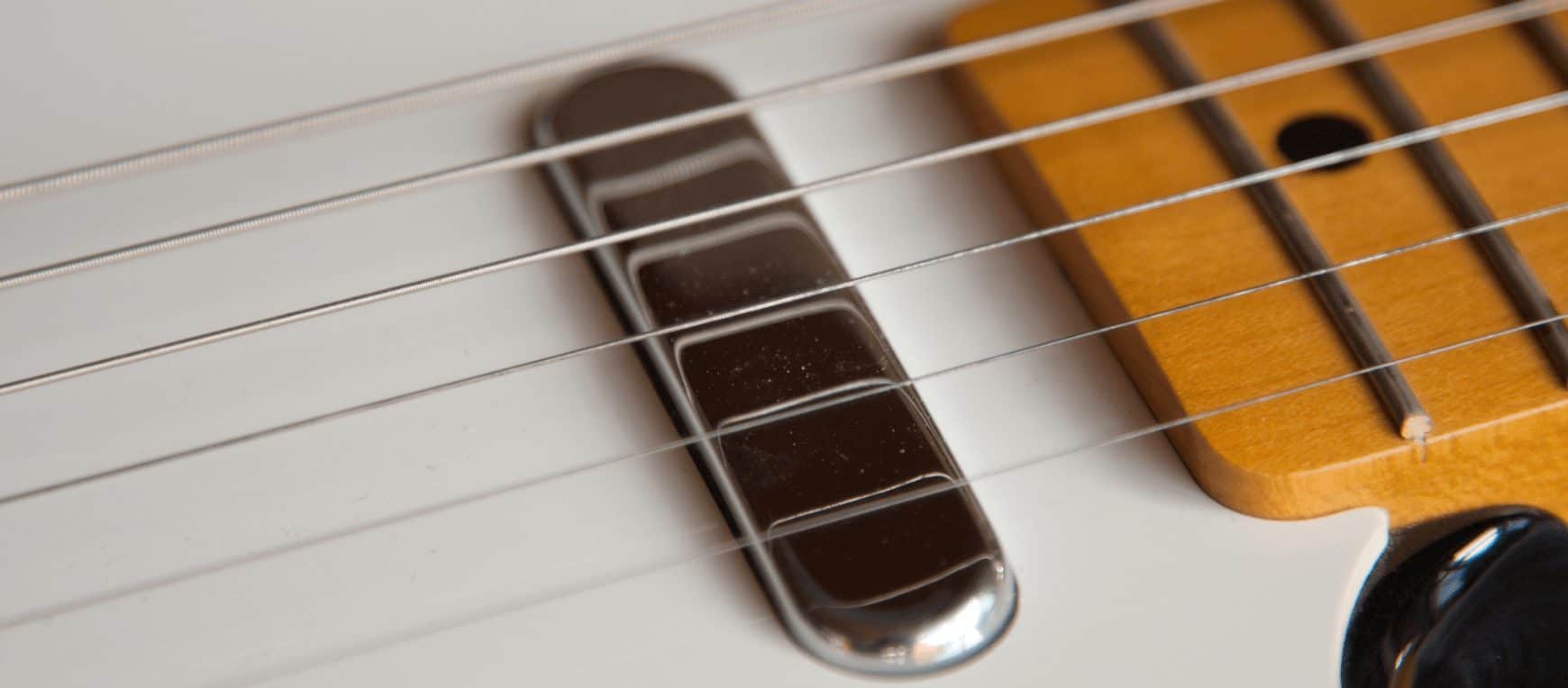For many guitarists, the idea of working on their acoustic guitars seems scary. They can be incredibly expensive, and they can seem much more delicate than their electric counterparts. This is especially true when it comes to intonation. It’s an essential part of making sure your guitar plays well, but the idea of filing your nut or saddle can be a bit intimidating.
Though it may be a bit more complicated than adjusting the intonation on an electric guitar, we’re going to cover how to do it on an acoustic guitar. With the right knowledge and approach, you can get your intonation set at home and have your guitar sounding great.
Basics of Intonation
First, let’s cover some of the basics around intonation. What even is intonation? Put simply, intonation is the accuracy of the pitch your guitar makes. If you play the A-string (or any string) open and at the 12th fret, they should be the exact same note but an octave apart. If you’ve ever picked up a guitar and noticed that chords sound a bit out of tune as you go up the fretboard—you’ve experienced poor intonation. Ideally, your guitar would be perfectly intonated; you would be able to play any chord or note anywhere on the fretboard, and it would still be completely in tune.
Now, let’s take a step back to understand how it all works. If you think back to elementary school music classes, you’ll probably remember learning about the basics of sound and pitch. The bigger the instrument, the more room for vibrations, the lower the pitch. Conversely, the smaller the instrument, the less room for vibrations, the higher the pitch. This same concept applies to intonation. The longer your string, the lower the pitch; the shorter the string, the higher the pitch.
What determines the length of your vibrating strings are the nut and saddle. Those are the two points of contact for the string, and the length between them is what determines your intonation. So if your saddle is too close to the nut, your guitar will be sharp. And if it’s too far from the nut, it will be flat. That may make it sound simple, but it gets much more complicated when you look at how to actually adjust the intonation on an acoustic guitar.

Why Adjusting the Intonation on Acoustic Guitars is More Complicated
For electric guitars, adjusting intonation is quite easy. Most electric guitars have individually adjustable saddles, typically requiring a quick turn of a screwdriver to adjust them. This makes adjustments a breeze, allowing you to quickly set your intonation. However, if you’ve played acoustic guitars, you know it’s not as easy.
Acoustic guitars rarely have individually adjustable saddles like electrics (though they do exist). Most often, their saddle is a single piece of bone (or other material) set into the bridge at an angle. There are no screws or knobs for a quick and easy adjustment. The only way to make an adjustment is to physically change the contact point for the saddle, usually by filing it.
Thankfully, acoustic guitar manufacturers do two things that make our jobs a little bit easier. The first is that they set the saddle in the bridge at an angle, making it so the lower strings are longer and the higher strings are shorter. This adds a degree of compensation to account for the thickness of the strings. The other is that they generally use compensated saddles instead of straight saddles. Compensated saddles are basically already adjusted to an extent to provide better intonation. With these two things combined, most acoustic guitars come already intonated or close enough for most.
However, that’s not always the case and stuff can happen that takes your guitar out of intonation. So when that happens, what do you do?

How to Adjust Intonation on an Acoustic Guitar
The first step to adjusting your intonation is making sure your guitar is set-up properly. That means a fresh set of strings, truss rod adjustments, any necessary fretwork, good action, etc. If you want more information on setting up your guitar, check out some of our past guides on guitar set-up. Once that’s done, you’re ready to move on.
The next step is to figure out what’s actually going on. Are your strings all sharp? All flat? Is your low-E flat and your high-E sharp? To figure this out, you just need a high quality tuner (or a really great ear, though a tuner is still recommended to double-check). The easiest way is to play an open string and compare it with the 12th fret. The notes should be exactly the same, but only an octave apart. You can also use the 12th fret harmonic for this, as many find it easier to hear the difference when using harmonics. Do this across all your strings and take note of what adjustments each one needs.
Now, you’re ready to do the actual adjustments. Thinking back to the elementary school example earlier, figure out what each string needs. If it’s flat, you need to shorten the string; if it’s sharp, you need to lengthen the string. Depending on what exactly is going on with your guitar, there are a few different approaches.
If you have a compensated saddle, you likely only need to make very minor changes. You need a saddle file. When filing your saddle, go slow. You can always file more, but you can’t add it back. Make very small adjustments, and check to see if they’re right. If you don’t have a compensated saddle, you may need to make larger changes. However, the same idea applies; go slow and make small adjustments. And as is obvious—make sure you’re filing in the right spots. Make sure that you are actually shortening or lengthening the string as is necessary. You don’t want to accidentally shorten a string that actually needs to be lengthened or vice versa.

Other Factors to Consider
For most cases, the information above is enough to get your intonation good enough. However, there are other things to keep in mind when it comes to intonation. For example, your nut can also have an impact on intonation. An improperly filed nut can result in your guitar being flat or sharp, and nuts can even be placed incorrectly and cause intonation issues. Make sure to check your nut as well if you’re having intonation problems.
Another thing to consider is the bridge itself, the piece that attaches to the top of the acoustic and where the saddle rests. Bridges can pull up, move, or be placed incorrectly. All of these can result in serious intonation problems, as well as other problems for your guitar. Though these can be fixed at home if you have the right tools and knowledge, we recommend going to a luthier if you have issues with your bridge. Moving or replacing your bridge can be a bit complicated, so don’t be afraid of calling up a trusted guitar shop for help.
There are also many other factors that contribute to intonation, including frets, strings, your playing style, and more. This is a big part of the reason why we recommend getting your guitar completely set-up before working on the intonation. Having a properly set-up guitar eliminates many of the other variables that can complicate things.
Lastly, general guitar care can be an important factor when it comes to intonation. Things like humidity and the truss rod can have a big impact on intonation. Always be sure to follow the basics of guitar care like maintaining humidity, fretboard maintenance, etc. It may be a bit annoying at first, but trust us—it’s worth it in the long run.
Conclusion
Adjusting your acoustic guitar’s intonation may seem like something you can’t do yourself, but most small adjustments can be made yourself with the right tools and knowledge. Get your guitar set-up, check your intonation with a tuner, and make small adjustments to your saddle with a file to compensate.
And as always for articles like this, don’t be afraid to go to a luthier if you aren’t comfortable with doing something. This is especially true if it’s a more complicated fix, like moving the bridge. It’s better to be safe than sorry, especially if it’s a guitar you really care about. If you ever feel like you’re in a bit too deep, just call up a luthier for help. They’re usually happy to explain what they did as well, which will help the next time you try to do it yourself.







3 Responses
thanx for your knowledge and I look forward for much more . thanx and be well !!!
Also, if one string intonation is flat or sharp, changing string gauge can do a lot without having to file the nut. Like changing the G string to a wound 20 gauge. Thanks
Check out Michael McConville videos.
His business is called Stringtech.
He shows the ultimate in acoustic guitar intonation.
It’s perfect and you don’t need squiggly frets.
It’s brilliant ( and much easier) on electric.